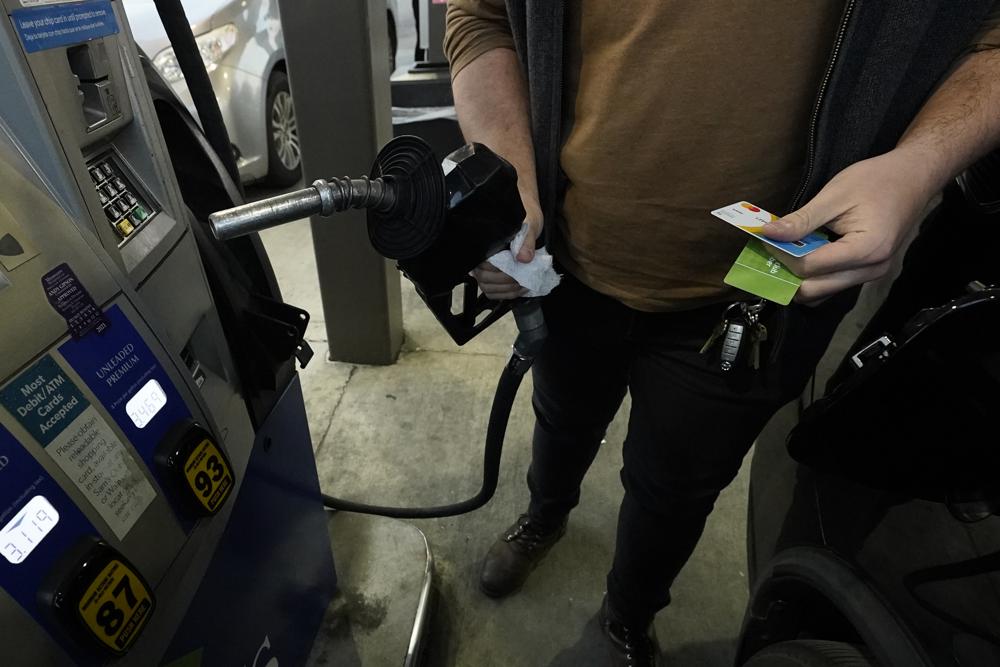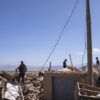FILE – A customer prepares to pump gasoline into his car at a Sam’s Club fuel island in Gulfport, Miss., Feb. 19, 2022. The U.S. economy shrank last quarter for the first time since the pandemic recession struck two years ago, Thursday, April 28, 2022, contracting at a 1.4% annual rate, but consumers and businesses kept spending in a sign of underlying resilience. (AP Photo/Rogelio V. Solis)
WASHINGTON (AP) — The U.S. economy shrank last quarter for the first time since the pandemic recession struck two years ago, contracting at a 1.4% annual rate, but consumers and businesses kept spending in a sign of economic durability.
The economy’s overall decline in the January-March quarter does not mean a recession is likely in the coming months. Most economists expect a rebound this quarter as solid hiring and wage gains sustain growth.
Instead, the steady spending by households and companies suggests that the economy will likely keep expanding this year even though the Federal Reserve plans to raise rates aggressively to fight the inflation surge. The first quarter was hampered mainly by a slower restocking of goods in stores and warehouses and by a sharp drop in exports.
“The report isn’t as worrisome as it looks,” said Lydia Boussour, lead U.S. economist at Oxford Economics. “The details point to an economy with solid underlying strength that demonstrated resilience in the face of Omicron, lingering supply constraints and high inflation.”
The Commerce Department’s estimate Thursday of the first quarter’s gross domestic product — the nation’s total output of goods and services — fell far below the 6.9% annual growth in the fourth quarter of 2021. And for 2021 as a whole, the economy grew 5.7%, the highest calendar-year expansion since 1984.
In addition to a drop in business inventories and a widening trade deficit, the first quarter’s weak showing also reflected a slowdown from last year’s robust rebound from the pandemic, which was fueled in part by vast government aid and ultra-low interest rates. With stimulus checks and other government supports having ended, consumer spending has slowed from its blistering pace in the first half of last year.
The economy is in an unusual position. Unemployment is near a 50-year low, and wages are rising at a healthy pace. Yet serious threats have emerged from widespread disruptions overseas and rampant inflation, which is eroding consumers’ spending power. Last month, prices jumped 8.5% from a year earlier, the fastest such rise in four decades.
Last quarter’s negative GDP number also undercuts a key political message of President Joe Biden. The president has pointed to rapid growth and strong hiring as a healthy counterpoint to soaring inflation, which is highly unpopular with voters and small businesses.
Compounding Biden’s political difficulties, Russia’s invasion of Ukraine and rising COVID cases overseas are weighing on the economy and heightening inflation pressures. Many companies are also still struggling to obtain the parts and supplies they need from tangled supply chains.
Imports surged in the first quarter, a sign that some of the supply snarls have eased. But ongoing lockdowns in China, including at its largest port, Shanghai, are likely to perpetuate shortages this year. Ford and General Motors have both said this week that they still can’t obtain all the semiconductor chips they need to build vehicles, costing them sales and forcing temporary plant closures.
A broader global slowdown is also expected this year, according to estimates last week by the International Monetary Fund. The 190-nation lending organization now foresees the disruptions of the Ukraine war and COVID slowing global growth to 3.6% this year from 6.1% last year.
Still, the U.S. job market — the most important pillar of the economy — remains robust. The number of people receiving unemployment benefits, a proxy for layoffs, fell to the lowest level since 1970. And in the January-March quarter, businesses and consumers increased their spending at a 3.7% annual rate after adjusting for inflation.
Economists consider that trend a better gauge than overall GDP of the economy’s underlying strength. Most analysts expect the steady pace of spending to sustain the economy’s growth, though the outlook remains highly uncertain.
Last quarter’s slowdown followed vigorous growth in the final quarter of 2021, driven by a surge in inventories as companies restocked in anticipation of holiday season spending.
Imports surged nearly 20% in the January-March quarter as businesses and consumers bought more goods from abroad while U.S. exports fell nearly 6%. That disparity widened the trade deficit and subtracted 3.2 percentage points from the quarter’s growth.
The weakness of the economy’s overall growth rate contrasts with the vitality of the job market. At 3.6%, the unemployment rate is nearly back to the half-century low it reached just before the pandemic. Layoffs have reached historically low levels as employers, plagued by labor shortages, have held tightly onto their workers.
Wages are rising steadily as companies compete to attract and retain workers, a trend that has helped maintain consumers’ ability to spend. At the same time, though, that spending has helped fuel inflation, which reached 8.5% in March compared with 12 months earlier.
Fed Chair Jerome Powell has signaled a rapid series of rate increases to combat higher prices. The Fed is set to raise its key short-term rate by a half-percentage point next week, the first hike that large since 2000. At least two more half-point increases – twice the more typical quarter-point hike — are expected at subsequent Fed meetings. They would amount to one of the fastest series of Fed rate hikes in decades.
Powell is betting that with job openings at near-record levels, consumer spending healthy and unemployment unusually low, the Fed can slow the economy enough to tame inflation without causing a recession. Yet most economists are skeptical that the Fed can achieve that goal with inflation as high as it is.
Copyright 2021 Associated Press. All rights reserved.
Source: https://apnews.com/article/us-economy-shrinks-in-Q1-7eb454a7874abeba545f8796edb38edb





























